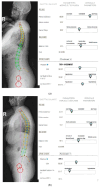Correlation Between Spinopelvic Parameters, Body Mass Index, Waist Circumference, and Chronic Non-Specific Low Back Pain
- PMID: 39859957
- PMCID: PMC11767003
- DOI: 10.3390/life15010016
Correlation Between Spinopelvic Parameters, Body Mass Index, Waist Circumference, and Chronic Non-Specific Low Back Pain
Abstract
Study design: This is an observational study.
Objectives: In general practice, it is noted that some people can deal more easily with a prominent belly than others. Recent use of spinopelvic parameters in the analysis of the spine might explain this observation. This study aimed to determine the correlation between pelvic incidence (PI), waist circumference (WC), and body mass index (BMI) in patients with non-specific chronic low back pain. We hypothesized that people with a low PI (non-pronounced lumbar lordosis) have significantly lower WC values than those with a high PI (pronounced lumbar lordosis).
Methods: Adult patients presenting to the outpatient neurosurgery clinic with non-specific chronic low back pain who had undergone full spine radiography were included. The PI, BMI, and WC were measured in all cases.
Results: We included 272 patients (male-female ratio, 1.08) with a mean age of 54 years. There was a statistically significant difference (p < 0.05) in the mean PI according to BMI group. The mean PI in our population was 57.8° (range 28.4-97.2°, SD 12.1°). A significant correlation coefficient of 0.271 (p < 0.001; 95%CI 0.157-0.377) was found between BMI and PI and 0.410 (p-value < 0.001; 95%CI 0.262-0.539).
Conclusions: We found a significant correlation between PI, BMI, and WC. This finding is the first step in confirming our hypothesis that a patient with a high PI might be able to tolerate being overweight and a high WC better than patients with a low PI, possibly because of their ability to retrovert the pelvis to a greater extent. Further research is warranted to investigate whether people with a high pelvic PI can better cope with obesity, especially those with a higher waist circumference and abdominal weight.
Keywords: body mass index; low back pain; pelvic incidence; spinal sagittal balance; waist circumference.
Conflict of interest statement
The authors declare that they have no affiliations with or involvement in any organization or entity with any financial interest in the subject matter or materials discussed in this manuscript.
Figures
Similar articles
-
Radiological analysis of lumbar degenerative kyphosis in relation to pelvic incidence.Spine J. 2012 Nov;12(11):1045-51. doi: 10.1016/j.spinee.2012.10.011. Epub 2012 Nov 14. Spine J. 2012. PMID: 23158969
-
Is There a Gender-Specific Full Body Sagittal Profile for Different Spinopelvic Relationships? A Study on Propensity-Matched Cohorts.Spine Deform. 2016 Mar;4(2):104-111. doi: 10.1016/j.jspd.2015.08.004. Epub 2016 Feb 2. Spine Deform. 2016. PMID: 27927541
-
Role of pelvic translation and lower-extremity compensation to maintain gravity line position in spinal deformity.J Neurosurg Spine. 2016 Mar;24(3):436-46. doi: 10.3171/2015.5.SPINE14989. Epub 2015 Nov 13. J Neurosurg Spine. 2016. PMID: 26565764
-
Using spinopelvic parameters to estimate residual lumbar lordosis assuming previous lumbosacral fusion-a study of normative values.Spine J. 2018 Mar;18(3):422-429. doi: 10.1016/j.spinee.2017.08.232. Epub 2017 Aug 16. Spine J. 2018. PMID: 28822824
-
Predicting ideal spinopelvic balance in adult spinal deformity.J Neurosurg Spine. 2011 Jul;15(1):82-91. doi: 10.3171/2011.2.SPINE1018. Epub 2011 Apr 8. J Neurosurg Spine. 2011. PMID: 21476795
Cited by
-
High hamstring stiffness and flexibility with comparable spinopelvic morphometry in amateur footballers: a multimodal study.BMC Sports Sci Med Rehabil. 2025 Jul 30;17(1):219. doi: 10.1186/s13102-025-01265-5. BMC Sports Sci Med Rehabil. 2025. PMID: 40739273 Free PMC article.
References
-
- Panuganti K., Nguyen M., Kshirsagar R. Obesity. StatPearls Publishing; Treasure Island, FL, USA: 2023.
-
- Chou L., Brady S.R., Urquhart D.M., Teichtahl A.J., Cicuttini F.M., Pasco J.A., Brennan-Olsen S.L., Wluka A.E. The Association Between Obesity and Low Back Pain and Disability Is Affected by Mood Disorders: A Population-Based, Cross-Sectional Study of Men. Medicine. 2016;95:e3367. doi: 10.1097/MD.0000000000003367. - DOI - PMC - PubMed
-
- Will J.S., Bury D.C., Miller J.A. Mechanical Low Back Pain. Am. Fam. Physician. 2018;98:421–428. - PubMed
LinkOut - more resources
Full Text Sources
Research Materials
Miscellaneous




